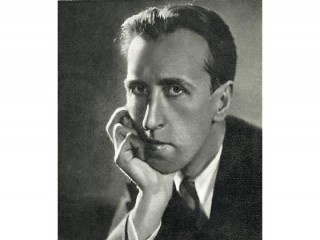
Dmitri Kabalevsky biography
Date of birth : 1904-12-30
Date of death : 1987-02-18
Birthplace : Saint Petersburg, Russia
Nationality : Russian
Category : Famous Figures
Last modified : 2022-03-16
Credited as : Soviet composer and pianist, conductor, Burgundian tunes, Colas Breugnon
The Soviet composer, pianist, and conductor Dmitri Kabalevsky was an important figure in the musical life of the Soviet Union. His compositions for children are among his best known and most successful works.
Dmitri Kabalevsky was born in St. Petersburg on December 30, 1904. In 1918 his family moved to Moscow, where he enrolled at the Scriabin Musical Institute. There he received formal instruction in music and piano. When he was only in his mid-teens he began giving piano lessons and composing simple pieces for his students. After leaving the institute in 1922 he continued to study intermittently with V. Selivanov (his piano teacher at the institute), taught piano, and played for silent movies.
In 1925 he entered the Moscow Conservatory, where he studied piano with Goldenweiser and composition with Catoire and, later, Miaskovsky. He began teaching composition at the conservatory in 1932 and was made a full professor in 1939. During these years he wrote his first major works and also served as senior editor at Muzgiz, the state-owned music publishing house. After he joined the Communist Party in 1940, he became a prominent personality in Soviet musical life and held important administrative positions in the musical establishment, including various offices in the Union of Soviet Composers, editor of Sovetskaia Muzyka (the official organ of the Union of Soviet Composers), head of the music department of the Soviet Radio Committee, and head of the music section of the Institute of Arts History in the Academy of Sciences. He was honored with the Order of Merit in 1940; with the Stalin Prize three times—in 1946 for his Second String Quartet, in 1949 for his Violin Concerto, and in 1951 for his opera The Taras Family—and with the Order of Lenin in 1965.
As a spokesperson for official musical policy he frequently appeared on television, addressed factory and farm workers, wrote articles for domestic and foreign newspapers and journals, presented awards, and led delegations. In 1959 he was part of a small group of Soviet composers who visited the United States.
Kabalevsky composed operas, ballets, choral works, incidental music for plays and radio productions, film music, four symphonies, a number of concertos, chamber music, songs, and piano pieces. Of these works, the best known in the West are the overture to his opera Colas Breugnon, The Comedians, a suite for small orchestra, his Second Symphony, the Violin Concerto, the Sonatina in C Major, and other piano works for children.
Kabalevsky, like other Soviet composers whose training and creative work began after the revolution, subscribed to the Soviet aesthetic theory that works of art should reflect political and social ideology. Many of his compositions extol the goals and aspirations of the Soviet Union and its people and commemorate important events in Soviet life and history. In the First Symphony (1932), dedicated to the revolution on its 15th anniversary, the music of the first movement with its funereal passages for double-bass, cello, and bassoon represents the Russian people under the Czarist regime, while that of the second and final movement, based on a folk theme, celebrates the people's rebellion and victory. The Third Symphony ("Requiem") was composed on the tenth anniversary of Lenin's death. The Requiem (1963) for solo voices, chorus, and orchestra was written in memory of the fallen Soviet heroes of World War II. His opera Colas Breugnon describes the life and world view of a 16th-century Burgundian craftsman. Romain Rolland, the author of the novel on which the opera was based, intended his book to be "without politics, without metaphysics …," but Kabalevsky and his librettist V. Bragin emphasize the social conflict between the craftsman and the feudal Duke and superimpose modern proletarian ideas on the story. Another opera, The Taras Family, deals with the struggle of partisan fighters against the invading Nazis in World War II.
After initially striking out on a modernistic musical path in early works such as the set of songs to words by Aleksandr Blok (1927) and the First Piano Concerto (1928), Kabalevsky settled into an essentially conservative style that changed little throughout his career. He was strongly influenced by the Russian romantic tradition of Tchaikovsky, Mussorgsky, and Borodin. His music is extroverted, charming, engaging, but not profound or challenging—characteristics that make it easily accessible and appealing to a wide audience. He utilized classical forms, traditional harmony (sparked by chromaticism and dissonance), broad lyrical melodies, and energetic rhythms. His scores tend to be transparent rather than thick-textured. The folk element plays an important part in his works. He incorporated folk material either by direct quotation of folk songs or by writing melodies that have a folk-like flavor. While working on Colas Breugnon he made a study of French folk songs. A number of the scenes in the opera have a folk flavor, but only two brief themes are taken directly from Burgundian tunes. In his Violin Concerto he used a popular Ukrainian folk song for the second theme of the first movement, and in the 24 Preludes for Piano (1943) he based each prelude on a folk song.
Kabalevsky maintained a life-long interest in young people both as composer and teacher. His tuneful, direct, buoyant style seems particularly well suited to the composition of children's pieces. He wrote songs, choral ensembles, and piano pieces for children. The three concertos—for violin (1948), cello (1948-1949), and piano (1952)—dedicated to "youth" and meant to be played by young musicians are full of vitality and joy. These works are a significant contribution to the repertory of children's music and represent one of Kabalevsky's most valued accomplishments. The U.S.S.R. reported his death on February 18, 1987.
















